Italian cuisine frequently uses a form of cured beef called guanciale. It has a rich, fatty flavor and is prepared from the jowl or cheek of a pig.
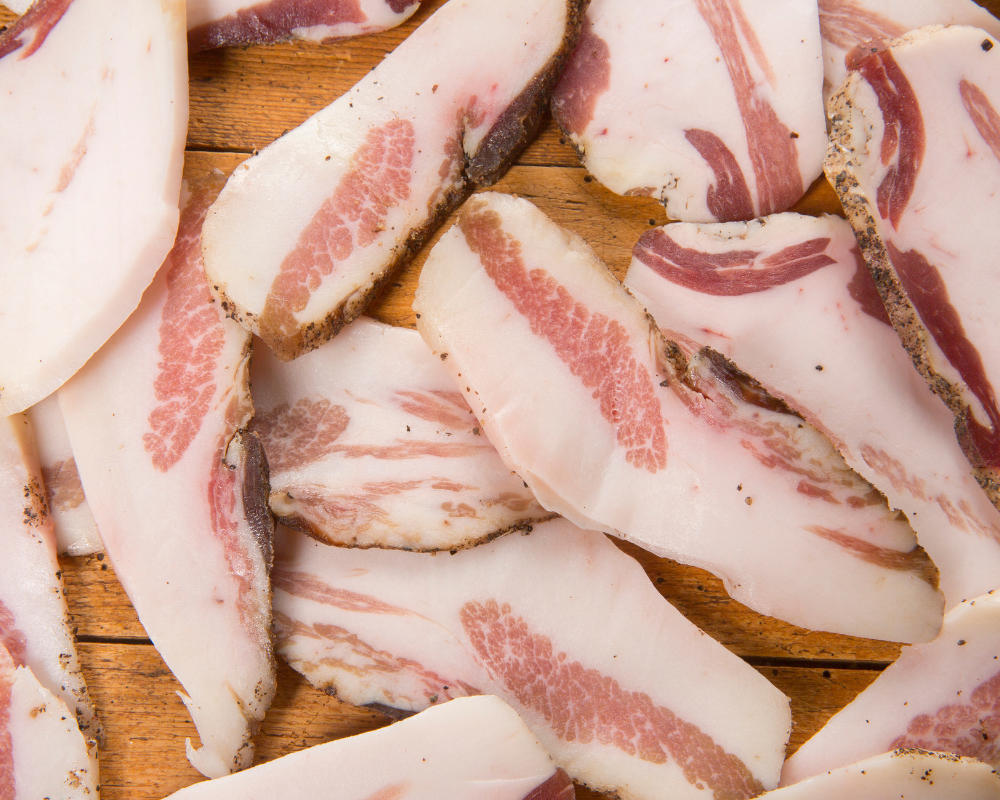
Pizza can also be topped with guanciale, which is frequently used in pasta recipes like carbonara, amatriciana, and gricia.
Guanciale is made by curing the beef for several months in salt and a variety of herbs and spices.
The outcome is a delicious meat that is frequently used in recipes in place of bacon or pancetta. Guanciale might be difficult to locate in some places, but it is usually available at specialist meat markets or online.
Guanciale is a special and mouthwatering ingredient that gives a range of meals richness and depth. Guanciale is a meat that is absolutely worth including in your next meal, regardless of whether you are an experienced cook or are just beginning to experiment with Italian food.
What is Guanciale?
Guanciale is a type of cured meat that is made from the pork cheek or jowl. It is a popular ingredient in Italian cuisine, specifically in central Italy, and is commonly used in pasta dishes such as pasta alla carbonara and pasta all’amatriciana.
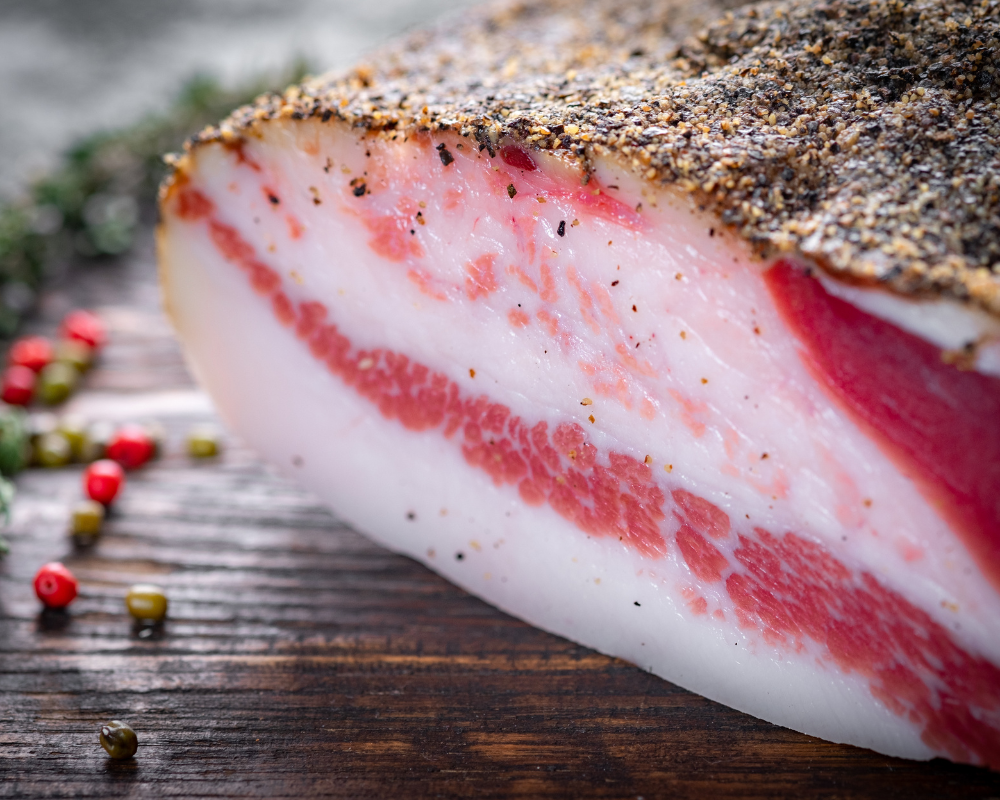
History
Guanciale has been a part of Italian cuisine for centuries. It was traditionally made by farmers who would use the pig’s cheek or jowl, which was considered a less desirable cut of meat, to create a flavorful and rich cured meat.
Today, guanciale is still made using the same traditional methods, but is now a highly sought-after ingredient in many Italian dishes.
Production Process
The production process for guanciale involves curing the pork cheek or jowl with salt and other seasonings for several weeks.
The curing process helps to preserve the meat and also gives it a distinctive umami flavor. After the curing process is complete, the guanciale is typically smoked to add additional flavor and depth.
One of the defining characteristics of guanciale is its rich, buttery texture and salty flavor. The high fat content in the pork cheek or jowl gives guanciale its signature texture and flavor, which is why it is often used in dishes that require a lot of flavor and richness.
In summary, guanciale is a type of cured meat made from the pork cheek or jowl. It has a distinctive flavor and texture, and is a popular ingredient in many Italian dishes. Its production process involves curing the meat with salt and other seasonings, and smoking it to add additional flavor.
Guanciale vs. Pancetta
Guanciale and pancetta are both Italian cured meats that are used in various dishes, especially pasta dishes. While they may seem similar at first glance, there are some key differences between the two.
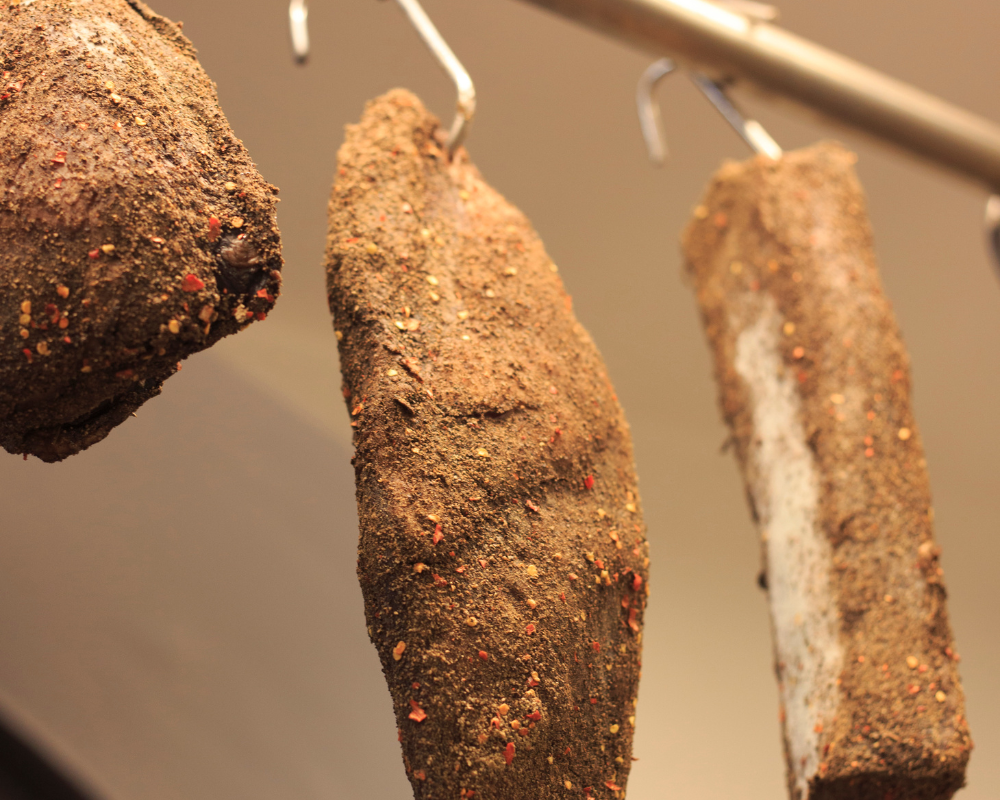
Origins
The main difference between guanciale and pancetta lies in their origins. Guanciale is made from pork jowl or pork cheek, while pancetta is made from pork belly. This difference in origin affects the texture and flavor of the two meats.
Fat Content
Guanciale contains more fat than pancetta, which gives it a richer, creamier texture. The fat in guanciale also renders more easily when cooked, which can add to the flavor of a dish. Pancetta, on the other hand, has a more uniform fat distribution throughout the meat.
Texture
While both guanciale and pancetta are cured meats, guanciale has a softer texture than pancetta. The meat practically melts in the mouth when thinly sliced, while pancetta has a firmer texture.
Flavor
The flavor of guanciale is more robust and tangy than pancetta, which has a milder, more pleasant taste. Guanciale lacks the smoky undertones of bacon, which is sometimes used as a substitute for guanciale in recipes.
Comparison Table
Here is a table summarizing the differences between guanciale and pancetta:
| Guanciale | Pancetta |
|---|---|
| Made from pork jowl or pork cheek | Made from pork belly |
| Contains more fat | Has a more uniform fat distribution |
| Softer texture | Firmer texture |
| More robust, tangy flavor | Milder, more pleasant flavor |
In summary, while guanciale and pancetta may seem similar, they have distinct differences in origin, fat content, texture, and flavor. When choosing between the two, it ultimately comes down to personal preference and the specific dish being prepared.
Guanciale in Italian Cuisine
Guanciale is a popular ingredient in Italian cuisine, especially in central Italy, including the regions of Lazio and Umbria. It is a type of Italian cured meat made from the jowl or cheek of a pig. Guanciale is known for its rich, buttery flavor and tender, delicate texture.
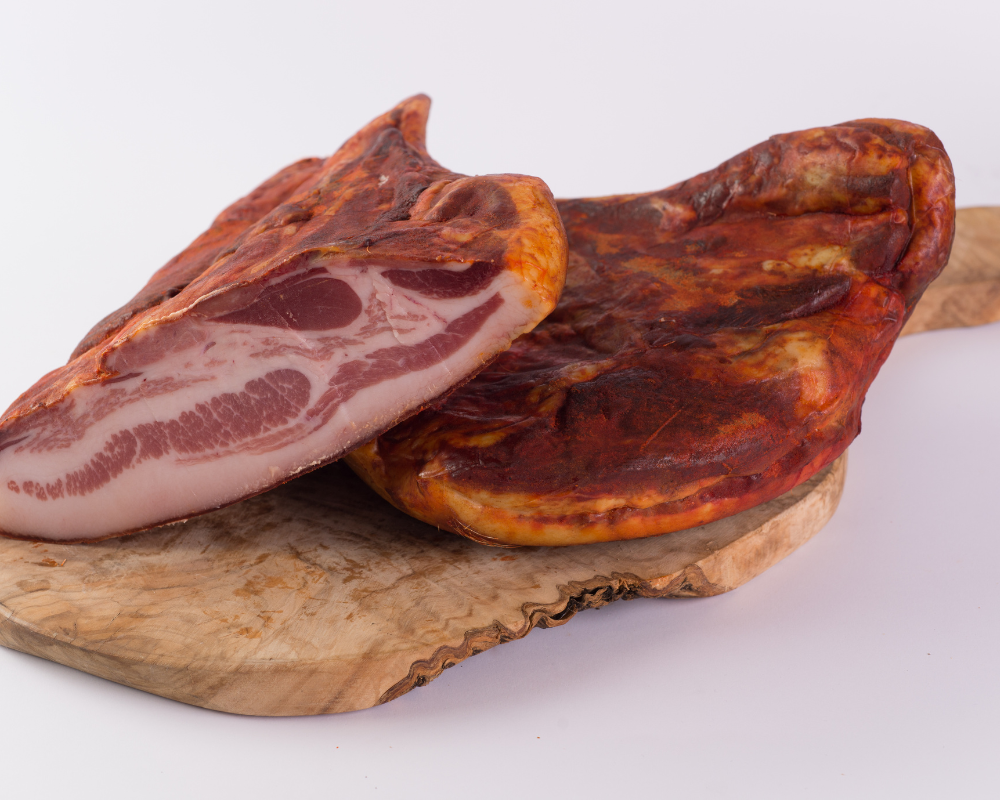
Classic Dishes
Guanciale is a key ingredient in several classic Italian dishes, including:
- Spaghetti alla Carbonara: This dish features spaghetti noodles tossed with a sauce made from guanciale, eggs, pecorino romano cheese, and black pepper. The guanciale adds a savory umami flavor to the dish and pairs well with the creamy egg and cheese sauce.
- Bucatini all’Amatriciana: This dish is similar to spaghetti alla carbonara but uses a tomato-based sauce made with guanciale, onions, tomatoes, and red pepper flakes. The guanciale adds a smoky, salty flavor to the dish and pairs well with the spicy tomato sauce.
- Pasta alla Gricia: This dish is similar to bucatini all’amatriciana but does not use tomatoes. Instead, the sauce is made with guanciale, pecorino romano cheese, and black pepper. The guanciale adds a rich, meaty flavor to the dish and pairs well with the salty cheese and spicy black pepper.
Regional Varieties
While guanciale is used in several classic Italian dishes, there are also regional varieties that use this ingredient in unique ways. For example:
- Pizza alla Carbonara: This pizza is made with a crust topped with guanciale, eggs, pecorino romano cheese, and black pepper. The guanciale adds a smoky, salty flavor to the pizza and pairs well with the creamy egg and cheese topping.
- Insalata di Farro con Guanciale: This salad features farro, an Italian grain, tossed with guanciale, rosemary, sage, and pecorino romano cheese. The guanciale adds a rich, meaty flavor to the salad and pairs well with the earthy farro and aromatic herbs.
- Zuppa di Lenticchie con Guanciale: This soup is made with lentils, guanciale, onions, carrots, celery, and tomatoes. The guanciale adds a savory umami flavor to the soup and pairs well with the hearty lentils and vegetables.
Guanciale is a versatile and flavorful ingredient in Italian cuisine. Whether used in classic dishes like spaghetti alla carbonara or regional varieties like pizza alla carbonara, guanciale adds a rich, meaty flavor to any dish.
Cooking with Guanciale
Guanciale is a delicious ingredient that can be used in a variety of dishes. Here are some tips on how to store and prepare it for cooking.
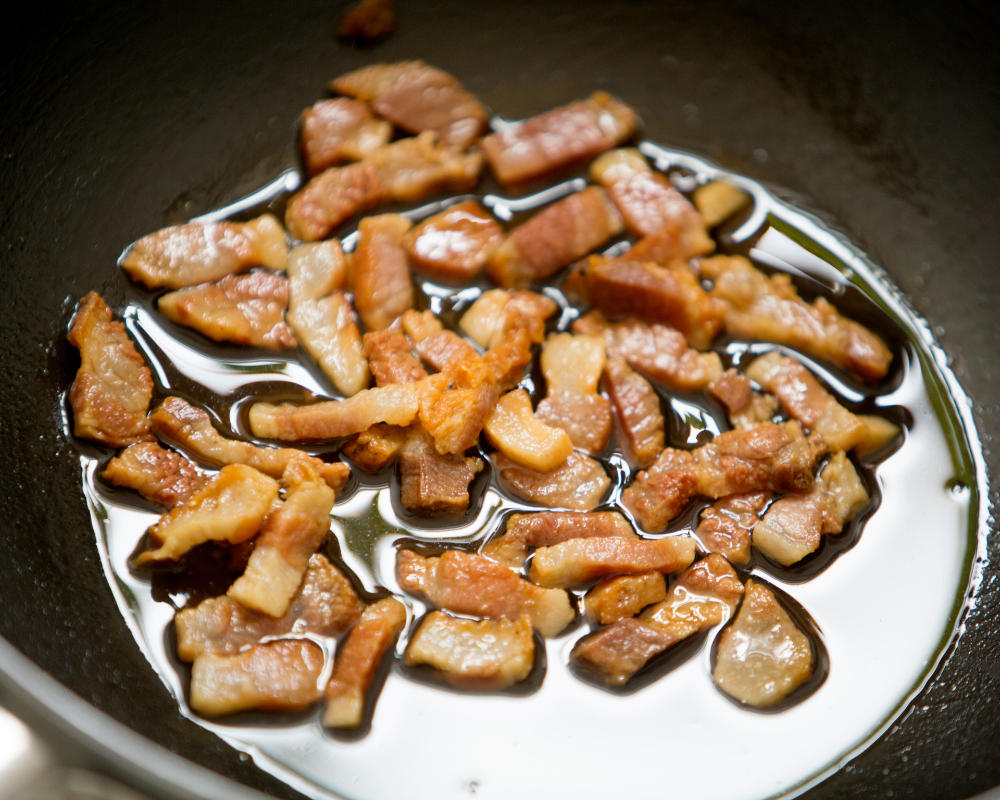
Storage
Guanciale should be stored in the refrigerator in an airtight container or wrapped tightly in plastic wrap. It can last for up to 3 months when stored properly.
Preparation Tips
Before cooking with guanciale, it is important to prepare it properly. Here are some tips:
- Cut the guanciale into small pieces or thin slices before cooking.
- Cook the guanciale slowly over low heat to render the fat and create a crispy texture.
- Use guanciale as a substitute for bacon or pancetta in recipes.
- Add guanciale to pasta dishes, soups, stews, and more for an added umami flavor.
- Use guanciale to add a buttery flavor to dishes.
- Guanciale pairs well with garlic, spices, sugar, and sea salt.
- Do not cook guanciale on high heat, as it can become tough and chewy.
- Use guanciale raw in salads or other cold dishes for a unique texture and flavor.
Guanciale is a versatile and delicious ingredient that can elevate any dish. With proper storage and preparation, it can be a staple in any kitchen.
Where to Buy Guanciale
Guanciale can be a bit more challenging to find than other types of cured meat, but there are several places where you can purchase it. Here are some options to consider:
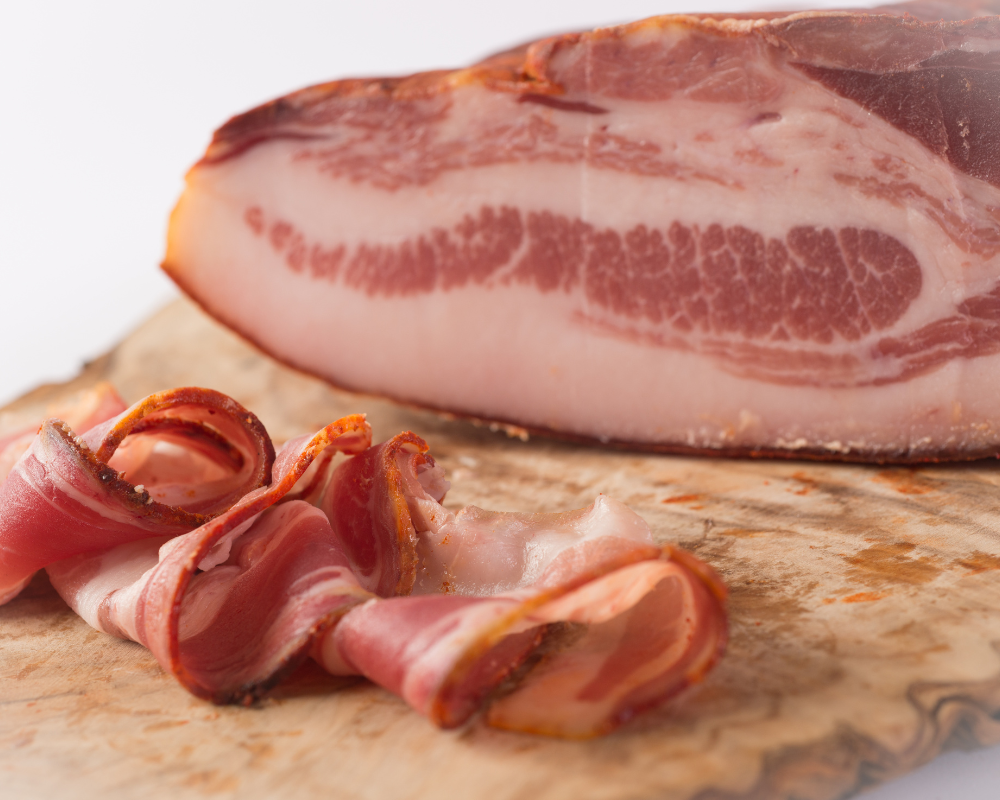
Italian Specialty Stores
Italian specialty stores are an excellent place to start when looking for guanciale. These stores often carry a variety of cured meats, as well as other Italian ingredients. You can find guanciale in slices or whole pieces at these stores.
Online Retailers
If you can’t find guanciale in your local area, consider purchasing it from an online retailer. Many reputable importers sell guanciale online, although it may be a bit more expensive due to shipping costs.
Supermarkets
Some supermarkets carry guanciale in their deli or meat departments. Check with your local supermarket to see if they have it in stock.
Farmer’s Markets
You may be able to find guanciale at your local farmer’s market. Many small-scale farmers produce their own cured meats and sell them at these markets.
Specialty Food Stores
Specialty food stores may also carry guanciale. These stores typically offer a wide variety of gourmet and hard-to-find ingredients.
When purchasing guanciale, make sure to check the expiration date and storage instructions. Once sliced, guanciale can be stored in an airtight bag in the refrigerator.
The meat will keep this way for about a week to 10 days, though if it’s a solid pork cheek, it may stay fresh for closer to a month.
There are several options for purchasing guanciale, from specialty stores to online retailers. With a little research, you can find the perfect source for this delicious Italian cured meat.
Guanciale: A Cultural and Culinary Experience
The Science of Cured Meat
Guanciale is a type of Italian cured meat that is made from the jowls of Berkshire pigs. The curing process involves rubbing the meat with a mixture of salt, pepper, and other spices before hanging it to dry for several weeks. The result is a rich, fatty meat with a delicate texture and intense flavor.
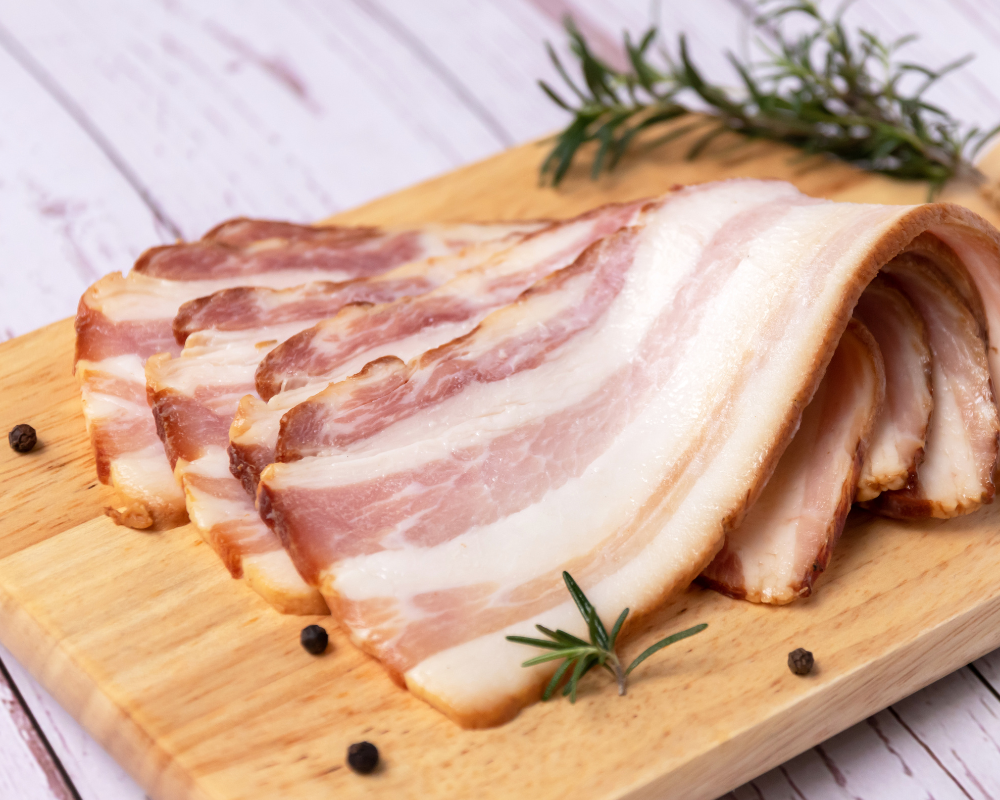
The science behind the curing process involves the use of salt to draw out moisture from the meat, which helps to preserve it and prevent spoilage.
The addition of spices and other flavorings enhances the taste of the meat and gives it a unique character that is distinct from other cured meats.
Guanciale in Italian Culture
Guanciale is an essential ingredient in many Italian dishes, particularly those from the regions of Lazio and Umbria.
It is a key component of classic pasta dishes like spaghetti alla carbonara and pasta alla gricia, as well as soups, sauces, and pizza.
In Italian culture, guanciale is highly valued for its rich, complex flavor and the unique texture it brings to dishes.
It is often paired with other cured meats like lardo and salumi to create a variety of delicious dishes that are beloved by food lovers around the world.
Traveling for Guanciale
For those who are passionate about food and travel, seeking out the best guanciale is a must-do experience.
Rome is a particularly great destination for guanciale lovers, as it is home to some of the best producers of this delicious pork product.
Travelers can visit local markets and specialty shops to sample different varieties of guanciale and learn about the different curing methods used by local producers.
They can also try their hand at cooking with guanciale by following traditional Italian recipes and experimenting with different flavor combinations.
Guanciale is a cultural and culinary experience that is not to be missed. Whether you are a seasoned foodie or a curious traveler, exploring the world of Italian cured meats is a journey that is sure to delight the senses and leave you with a newfound appreciation for the art of food.







Add comment